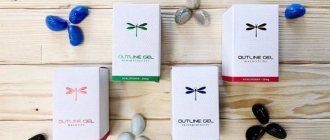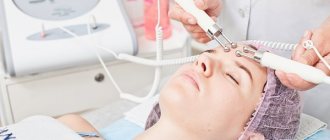When may earlobe suturing be necessary?
- You wore tunnels and decided to heal them, returning your ear to as natural a shape as possible.
- While stretching the tunnels, the lobe broke, you want to restore it and pull it further.
- Heavy earrings weighed down your ears.
Many people decide to sew up the earlobe after they get caught in an earring: even with a slight tug, you can tear the tissue.
How much does it cost to do
The cost of ear tunnels will depend on the method of stretching, the prestige and pricing policy of the piercing salon and the material of the plugs.
Let's consider the average cost of a service using various methods:
- puncture expansion - from 8 thousand rubles;
- lobe incision - from 4 thousand rubles;
- punching - 4.5-6 thousand rubles.
The cost of high-quality titanium-coated piercing tunnels varies between 2 thousand rubles per pair. Plastic decorations can be purchased for 300–800 rubles.
How is lobe reconstruction performed?
- You take off the jewelry and turn to the master.
- The master collects anamnesis, finds out if there are any allergies to medications, and talks about how the procedure will go.
- On the day of surgery, you should not drink alcohol or energy drinks or take blood thinners.
- You come for the procedure, the master administers local anesthesia and begins the reconstruction process - sewing up the ear.
- Be prepared that in the case of tunnels, some of the skin will have to be removed so that the lobe looks as natural as possible after suturing.
After reconstruction, you follow the specialist’s recommendations and treat your ear regularly.
Contraindications
The desire to become the owner of extreme jewelry is not enough. In some situations, tunnels are not recommended, particularly if you have the following health problems:
- poor blood clotting;
- allergic manifestations to the material used in the products;
- mental disorders;
- acute phase of chronic diseases;
- pregnancy and lactation;
- menstruation period;
- diabetes;
- epilepsy, neurological seizures;
- vegetative, neurological and mental disorders resulting from the use of alcoholic beverages;
- elevated body temperature.
It is important that you won’t be able to put the device into the earlobe at once. This part of the ear needs to be stretched gradually.
How long does it take for an ear to heal after a tunnel?
The first reactions - discharge of ichor, swelling, pain - disappear 1-1.5 weeks after the surgical correction procedure. At the same time, the specialist will invite you to remove the stitches. But the appearance of the lobe at this stage will be far from ideal: the surface is uneven, the skin is red, the scars stand out in color and density. Don't worry, this is not the final result. After 3-6 months, the lobe will lighten, the scars will smooth out, and it will be possible to notice that there are small marks on the skin only upon very close examination. However, such a scenario is possible with strict adherence to the rules of skin care after reconstruction.
- The wound must be treated regularly in the manner recommended by the specialist.
- You should not allow the ear to come into constant contact with clothing, hair, or hats, as this will slow down healing.
- You cannot re-pierce your ears or put on tunnels until the regeneration process is complete.
Possible complications
Incorrect piercing and negligent attitude to caring for the earlobe provoke various kinds of complications.
Some of them can be easily dealt with; in critical cases, a person is forced to resort to surgery.
Itching
Peeling of the skin and itching in the area of the stretched puncture may occur due to an allergic reaction to the material of the jewelry. Under such circumstances, the fashionable device is replaced.
A steel product is considered ideal. During wearing, the earlobe should be regularly treated with Chlorhexidine.
Sepsis
The resulting hole in the earlobe is, in fact, an open wound and favorable pathogenic microflora for the proliferation of bacteria.
The tissues swell, the body temperature rises, and there is a risk of blood poisoning (sepsis). A weakened immune system and diabetes increase bacterial production activity.
As a result, the person will face long-term antibiotic therapy, and in some cases, removal of the source of infection, that is, the inflamed area of the earlobe.
Blowout growth
If you “skip sizes” and pull the lobe too quickly, a rather unpleasant thing can form in a certain area, namely, a growth.
In such circumstances, it is better to seek help from a surgeon. It will numb the problem area and remove the spherical tumor.
If the growth is small, stretching can be resumed after six months. It is better to choose a steel product as a tensile element.
The appearance of blisters
Blistering is included in the possible consequences of this type of piercing, such as tunnels. As a rule, the reason lies in illiterate care and individual characteristics of the human body.
Any piercing can seriously disrupt the functioning of all important systems. Therefore, if blisters or purple spots appear near the puncture, you should immediately remove the plug and consult a doctor.
Facial nerve paralysis
With any surgical procedure that follows all sanitary rules, serious complications can develop. Facial paralysis is no exception.
The organ of hearing is a complex combination of bioactive points, so any puncture in this area of the face has a certain effect on the functioning of individual organs.
Infection of the hole also leads to undesirable consequences. Most often, clients of piercing salons develop Bell's palsy.
In this case, the person feels numbness, heaviness in the face, and pain near the affected area. In this case, you cannot do without qualified medical care.
What determines the rehabilitation period after lower blepharoplasty and the recommendations of specialists. In this article we will discuss the price of endoscopic forehead and eyebrow lift.
Follow the link https://cosmetolog-expert.ru/plastika-litsa/nos/rino/metodiki-repozitsii-kostey.html if you are interested in indications for repositioning the nasal bones.
Inflammation of cartilage tissue
Insufficient adherence to antiseptic rules during puncture expansion (non-sterile instruments, insufficient treatment of the desired area, violation of hygiene rules after piercing) leads to infection of the formed wound with pathogenic bacteria.
This entails an inflammatory process in both the soft and cartilaginous tissues of the ear. Pus is released from the puncture area, and the person experiences throbbing pain in the affected area.
In this case, the pathology should be treated by an otolaryngologist, and surgical intervention is not excluded. Antiseptic drugs and antibiotics are used as conservative methods.
Lobe rupture
Intense stretching of the ear often ends in rupture of the earlobe. In this case, you need to contact an otolaryngologist.
A specialist will professionally sew up the gap, observing sanitary standards. In some cases, the lobe is torn specifically for the installation of rods.
This decoration has a truly original and impressive look.
Hearing loss
If a specialist, while performing technical manipulations with the earlobe, injures the hearing aid, there is a risk of permanent hearing loss.
In addition, due to stretching, the auricle can change its original shape, which will cause disturbances in sound vibrations.
Tissue necrosis
This complex phenomenon occurs due to impaired blood circulation in the lobe. Tissue necrosis is the most difficult to deal with.
Nutrients stop entering the tissue structure, cell nutrition is disrupted. Gradually, the cells die, which leads to the death of part of the lobe.
The problem is solved by surgery, that is, removal of the necrotic area.
Allergy
If the healing process is accompanied exclusively by itching, then this can be regarded as normal.
However, if bubbles, blisters, swelling, or redness appear, which disappear after removing the jewelry, this indicates the presence of an allergic reaction to the material.
The earring will need to be replaced and anti-allergic medications will need to be started.
When can new tunnels be inserted into sutured ears?
If your plans did not include getting rid of body modification, but only stitching up tears, then repeated piercing and wearing tunnels are allowed. But it is recommended to do this no earlier than 6 months after reconstruction. The same applies to regular ear piercing. If you rush and make a new hole before tissue regeneration is complete, then the puncture may subsequently migrate to the side. In addition, there is a high risk of infection of a wound that has not completely healed or a new rupture.
Now you know that lobes can be restored after injuries and body modifications. The main thing left is to choose a master to whom you will entrust your beauty and health. Contact only experienced specialists with specialized education.
Do ears become overgrown if you don't wear earrings for 2 weeks?
If the piercing is fresh, then after a break in wearing earrings it may seem that it is overgrown. It manifests itself like this: when you try to insert an earring into your ear, you feel resistance, and you feel some kind of “lump” in the earlobe. In fact, most often this seal is a punctured hole, it’s just difficult to get into. Even with “fresh” punctures, inflammation often occurs - the lobe around the hole swells a little, turns red, and suppuration may appear. This process gives the feeling that the hole is overgrown, but you just need to remove the inflammation - treat the lobe with an antiseptic, and then try to put on the earrings again. If the inflammation is not removed, the holes may become overgrown.
Punctures in the ears heal quickly if they were made recently and become inflamed - the body directs its forces to regeneration, and a “plug” appears at the puncture site. A hole in the ears can also close up if it was pierced incorrectly - in the wrong area of the earlobe, at the wrong angle. But even in this case, it is possible that the puncture will not heal, but will simply cause inconvenience - it can become deformed (stretched) and hurt.
If the piercing was done long ago and correctly, then the ears will not heal. At least, this is what happens in most cases - when the puncture is made in the anatomically correct place and for a long time, the body will not strive to “overgrow” it and, thus, get rid of it. Although if a person has an incredible ability to regenerate, then the holes in the earlobes can heal even after 10 years of wearing earrings. True, how long you will have to not wear jewelry for this is difficult to say.
Folk method
How to heal holes in the ears using traditional methods? I would like to immediately note that there are no miracle herbs that can instantly heal tissue. But some recommend a very barbaric technique - stretch the earlobe and insert a hot needle into the hole. The operating principle is that the formed canal walls are burned, and the exposed tissues grow together. As a result, a tiny whitish scar should remain on the lobe, almost invisible to others.
But not everyone will risk trying this dangerous and traumatic method, and its effectiveness is highly questionable.
Scar removal creams
The next method to remove a hole in the ear from an earring is to use various creams to absorb scar tissue. They are applied to the problem area or made as compresses at night. Usually you have to wait quite a long time for results - weeks, and sometimes months.
Also, judging by customer reviews, fresh punctures heal well and newly formed scar tissue resolves. But if the problem is more than 3 years old, then this remedy may not help.
What earrings are used, their types, sizes
Installed accessories according to size and shape are classified into:
- Miniature. They are suitable for young girls who have decided to undergo such extreme body modification for the first time. Such delicate jewelry has a maximum diameter of 8 mm. They do not require overly hypertrophied holes.
- Medium size. Such accessories are considered standard and have a diameter of up to 10-12 mm.
- Large ones. Such jewelry has a size of 12-15 mm, looks catchy and quite extreme. The operation is quite traumatic.
- Maximum size. Accessories that attract increased attention from others can reach a diameter of 25 mm. To create such a hole, special surgical techniques are used.
The tunnels in girls' ears look unusual, extravagant and extreme due to the well-chosen design of the jewelry. Such products come in various models and designs.
They can carry only an aesthetic component or have a symbolic meaning, indicating that their owner belongs to a certain subculture or reflecting her worldview.
The types of accessories for ear tunnels are presented in the table below.
| Product type | Features and Specifications |
| O-rings | They are rings with silicone seals. Easily installed into a surgically formed hole. Seals fix the jewelry in the hole and create an optical illusion of greater volume. |
| Single breasted plugs | Such accessories are distinguished by the fact that one of the edges is wider than the product itself. This is called boarding. To ensure a secure fit in the ear, such elements are reinforced with a special elastic band that prevents them from falling out. |
| Jewelry with saddle | Their diameter gradually increases towards the edges. They have a curved shape, giving them the appearance of a miniature saddle. Made from biocompatible steel alloy or animal horns. Thanks to the extended edges, retaining seals are not required. Saddle jewelry is difficult to insert into the newly formed tunnels. |
| Screw-Fit | These models have screw-down sides. The unscrewing part is located on the back of the ear. Decorations of this design can be through or muted. Such models are lightweight and easy to use. |
| Push-Fit | Prefabricated structures consisting of 2 parts. A front element with an original and thematic design is inserted into the back, forming a complete decoration. Push-Fit has a threaded rod foot. The rear element is designed in the form of a miniature flask. |
Each ear tunnel jewelry option has its own set of advantages and disadvantages. They are made from natural, polymer and composite materials.
The most common:
- acrylic;
- non-oxidizing metal alloys;
- wood;
- bone;
- stone;
- horns;
- glass;
- silicone;
- porcelain.
Ear jewelry made from ivory and wild animal horns are considered especially chic among adherents of youth subcultures.










